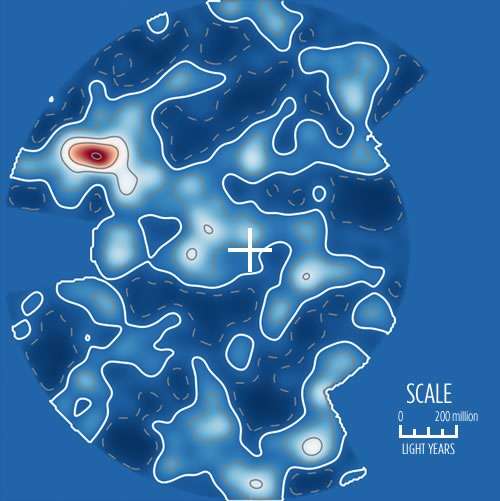A slice through the 3D map of the nearby universe. Our Milky Way galaxy is in the centre, marked by a cross. The map spans nearly two billion light years from side to side. Regions with many galaxies are shown in white or red, whereas regions with fewer galaxies are dark blue.
Astrophysicists have created a 3D map of the universe that spans nearly two billion light years and is the most complete picture of our cosmic neighbourhood to date.
The spherical map of galaxy superclusters will lead to a greater understanding of how matter is distributed in the universe and provide key insights into dark matter, one of physics' greatest mysteries.
Professor Mike Hudson, Jonathan Carrick and Stephen Turnbull, of the Department of Physics and Astronomy at the University of Waterloo, and Guilhem Lavaux the Institute d'Astrophysique de Paris of the Centre national de la recherche scientifique of France, created the map. Professor Hudson is also an affiliate member of the Perimeter Institute for Theoretical Physics.
"The galaxy distribution isn't uniform and has no pattern. It has peaks and valleys much like a mountain range. This is what we expect if the large-scale structure originates from quantum fluctuations in the early universe," said Hudson, also associate dean of science, computing.
The map appears online in the peer-review journal, Monthly Notices of the Royal Astronomical Society, one of the world's leading primary research journals for astronomy and astrophysics.
The lighter blue and white areas on the map represent greater concentrations of galaxies. The red area is the supercluster called the Shapley Concentration, the largest collection of galaxies in the nearby universe. Unexplored areas appear in medium blue.
This first video shows the density field smoothed with a Gaussian window of 10 Mpc/h:
Knowing the location and motion of matter in the universe will help astrophysicists predict the universe's expansion and identify where and how much dark matter exists.
Scientists have observed that galaxies move differently because the universe's expansion is not even. These differences are called peculiar velocities. Our own Milky Way galaxy and its neighbour Andromeda are moving with a speed of 2 million kilometres per hour.
Previous models haven't fully accounted for this observed motion. Hudson and his team are interested in discovering what structures are responsible for the peculiar velocities.
This second video shows the density field smoothed with a Gaussian window of 4 Mpc/h:
These deviations in the motion of galaxies are a valuable tool to determine the distribution of matter and dark matter on the largest scales.
Dark matter accounts for a large majority of the mass content in the universe. It is a hypothesized form of matter particle that does not reflect or emit light and as a result it can't be seen or measured directly. The existence and properties of dark matter can only be inferred indirectly through its gravitational effects on visible matter and light.
"A better understanding of dark matter is central to understanding the formation of galaxies and the structures they live in, such as galaxy clusters, superclusters and voids," said Hudson.
The next step will involve getting more detailed samples of peculiar velocities to enhance the map, in collaboration with researchers in Australia.
More information: Monthly Notices of the Royal Astronomical Society, mnras.oxfordjournals.org/conte … t/450/1/317.abstract . arxiv.org/abs/1504.04627
Journal information: Monthly Notices of the Royal Astronomical Society
Provided by University of Waterloo























